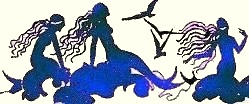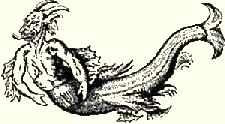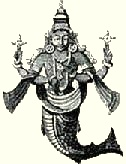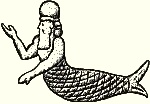

Mythical Mermaids
 Odysseus paid them a visit, and uncounted renaissance artists painted them that way: human above waist, fishy below.
Odysseus paid them a visit, and uncounted renaissance artists painted them that way: human above waist, fishy below.| »First you will come to the Sirens who enchant all who come near them. If any one unwarily draws in too close and hears the singing of the Sirens, his wife and children will never welcome him home again, for they sit in a green field and warble him to death with the sweetness of their song. There is a great heap of dead men's bones lying all around, with the flesh still rotting off them.« from The Odyssey translated by Samuel Butler |



 During the times of the classical antiquity dugong abounded along the coasts of the Red Sea and the Indian Ocean.
During the times of the classical antiquity dugong abounded along the coasts of the Red Sea and the Indian Ocean.  Greek, Phoenician and Egyptian seafarers had been able to observe dugong in Arabian waters. When they observed a herd of dugong from a higher point of view such as a cape or masthead they saw elegant, slender creatures passing by with graceful yet powerful movements of their tail fin.
Greek, Phoenician and Egyptian seafarers had been able to observe dugong in Arabian waters. When they observed a herd of dugong from a higher point of view such as a cape or masthead they saw elegant, slender creatures passing by with graceful yet powerful movements of their tail fin.
 The mermaid myth was born.
The mermaid myth was born.

Readers of the Dugong Pages drew my attention to another interesting detail in the earlier human history:
In the 2nd Book Mose (Exodus, Book of Names) the Israel People were instructed to build the first Tabernacle. The tarpaulin of the inner tent should be made of the hide of a certain animal (hebrew: tachash skins, the exact identity of this animal is uncertain - Wikipedia). In some language versions the animal was specified as Seacow. Others specified dolphin, seal or, in Luther's version, badger.
We will never know for certain what material was requested in the original instruction. Older scientific names for the Dugong took account of this myth, E. Rupell called them Halicore tabernaculi.
In the 2nd Book Mose (Exodus, Book of Names) the Israel People were instructed to build the first Tabernacle. The tarpaulin of the inner tent should be made of the hide of a certain animal (hebrew: tachash skins, the exact identity of this animal is uncertain - Wikipedia). In some language versions the animal was specified as Seacow. Others specified dolphin, seal or, in Luther's version, badger.
We will never know for certain what material was requested in the original instruction. Older scientific names for the Dugong took account of this myth, E. Rupell called them Halicore tabernaculi.
written 23 Jan 00
last edit 14 May 01